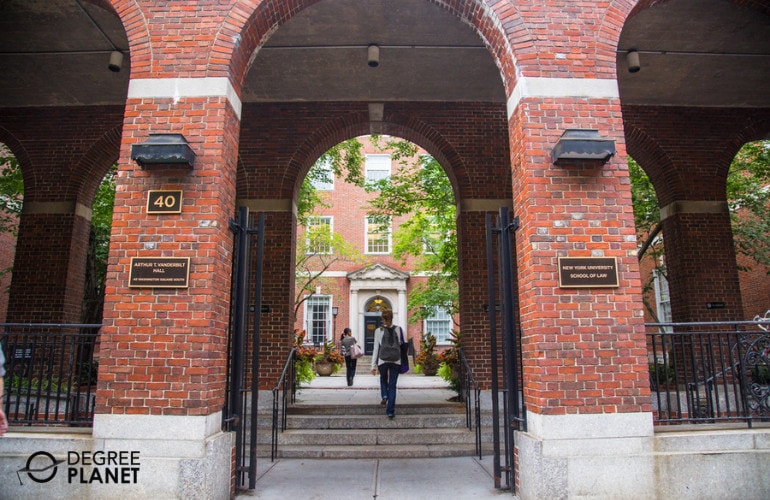The best schools to transfer to offer high acceptance rates for transfer students, make it easier to get credit for your past work, and support you throughout the switch.

If the time has come for you to enroll in a different college, then finding a school with easy transfers can help the process go more smoothly and quickly.
Editorial Listing ShortCode:
Switching schools takes effort, but it’s an endeavor that pays off for many students. Before you take the plunge, you may want to read through this transfer guide so that you’ll know what to expect and how to go about the process.
What Are the Best Schools to Transfer To?

It’s not uncommon to switch schools partway through your college career. Many students transfer for one reason or another.
Maybe you began your studies at a 2 year community college and are now ready to switch to a 4 year program. Maybe your higher education had been interrupted by various life circumstances, but now you’re ready to go back. There’s also the possibility that your current school has gotten too expensive, so you’re looking for a more affordable option.
Editorial Listing ShortCode:
Some students transfer because they’re moving and need a college that’s closer to their new home. Others’ schedules may have gotten busier, so they’d prefer the convenience of online studies. For whatever reason you need to switch, you may be looking for the easiest colleges to transfer into.
Transferring schools can be a lengthy, involved process with many steps, but the following three characteristics are often considered factors that can make the process a bit quicker or simpler.
Colleges with High Transfer Acceptance Rates

Some schools accept more transfer students than others. If you apply to colleges with high transfer acceptance rates, you can increase your chances of landing a spot at one of your chosen schools. Some highly selective colleges accept under 5% of transfer applicants, but not every college is like that.
You may be encouraged to know that there are other colleges that accept over 90% of their transfer applicants. Some schools take thousands of transfer students each year. While an exceptionally impressive application packet might help you get into even the most selective of schools, you may find the transfer process less stressful if you apply to colleges with high acceptance rates.
Besides, if you enroll at a school with high acceptance rates, there’s a good chance you’ll be surrounded by other students in the same boat. You may befriend other transfers, and you can rest assured that the college is used to dealing with transfer students.
Colleges That Accept the Most Transfer Credits

Schools vary in what percent of a degree’s requirements you can transfer into their programs. Some colleges let you bring 25% or 50% of the credit requirements in from another school. Others allow you to earn up to 75% of the required credits elsewhere.
If you’ve already completed several years of college, then schools that accept the most transfer credits will likely be at the top of your list. The more credits you can transfer in, the more time and money you can save. Otherwise, you may end up needing to repeat classes that you’ve already passed.
Academic residency requirements can be thought of as the reciprocal to this idea. Residency policies specify how much of the coursework for a major must be earned at the degree-granting college. For example, you may be required to complete at least half of the program-specific courses for your major at your new school. Less-stringent residency requirements offer greater flexibility.
Colleges with Special Transfer Admissions Programs

Colleges often have special arrangements with one another. In some instances, a community college may have transfer agreements with a few four-year colleges. Such arrangements, which are often known as articulation agreements, can simplify the process of bringing credits to another school.
For example, a particular four-year school may agree to accept any graduate of your community college. Your entire associate degree would count toward the requirements for a bachelor’s degree. In another scenario, one college may have already reviewed another school’s curriculum to determine which courses are equivalent to their own.
Editorial Listing ShortCode:
When you submit your transcripts for review, their office can quickly determine which degree requirements you’ve already completed and which you still need to take. Arrangements like this can provide the peace of mind that your previous coursework will hold value when you transfer. They can also help the transfer process move more quickly.
How to Transfer Schools

The college transfer process takes time. It begins with considering a move and ends once you’ve gotten established at your new school. Here are some of the common steps involved in the transfer process:
- Consider your options. There’s a lot to think about when it comes to a college transfer. Do you really want to change colleges? If so, why? What features would you like your new school to offer? Is there a different academic program you’d like to pursue? It’s helpful to figure out the answers to questions like these before moving forward with the transfer process.
- Make a list of schools. If you’re committed to the idea of transferring, you can pick out several colleges that you’d be willing to attend. It’s strategic to select a few reach schools and a few where you’re more likely to get in. You may want to prioritize colleges with high transfer rates, high credit acceptance, or articulation agreements with your previous institution.
- Prepare application packets. The admission requirements for transfer students can often include college transcripts, reference letters from professors, and an essay about why you want to transfer. Once you prepare your materials, you can submit them.
- Have your credits reviewed. After you’ve been accepted to a school, you can find out how many of your credits will transfer in. The new college will do what’s called credit review to determine this.
- Take advantage of school supports. Once you’ve enrolled in a new school, the process is just about complete! It’s beneficial to take advantage of any special services, such as social events for transfer students. They may help ease your transition process.
If you need help along the way, you can touch base with the admissions office at the new school.
Tips for Transferring Colleges

There’s a lot to think about when it comes to transferring schools, but the following tips can help you keep everything in order.
- Look at multiple schools. Transfer applicants may or may not be accepted. If you’re set on transferring, it’s strategic to apply to several places. To increase your chances of an acceptance letter, you may want to select reach, match, and safety schools.
- Work hard on your application packets. The application process can be just as rigorous for transfer admissions as it was for freshman admissions—perhaps even more so. It can help to start filling out your applications early, asking professors to write reference letters, and confirming that your college GPA meets admissions requirements.
- Focus on the positives. You may need to write a personal statement about your reasons for transferring. It’s strategic to highlight the positives that the new college will offer rather than pointing out the negatives of your previous institution.
- Get credit for your courses. Transferring credits to the new college can save you time and money. You may receive the most benefit if you transfer to a program that has an articulation agreement with your first school. If not, it’s necessary to ask the new college to review your transcripts.
- Deal with financial aid. Student aid doesn’t automatically follow you to your new school. You can get in touch with the financial aid offices of both your previous college and your new one to find out what steps you need to take.
While transferring schools can be hard work, you may find the effort worthwhile once you’re settled at a school that’s the right fit for you.
Transfer Admission vs. Freshman Admission Rates
Getting into school as a transfer is sometimes more difficult than gaining freshman admission. Here are some things you should know.
| Transfer Admission | Freshman Admission |
|
|
Transfer acceptance rates vary widely from one college to the next. Some transfer universities even accept a higher percentage of transfer applicants than freshman applicants.
Why Accreditation Is Important When Transferring
Hopefully, the credits you’ve earned so far have come from an accredited school. If so, you’ll probably have an easier time transferring them to your next college.
Editorial Listing ShortCode:
Regional accreditation is the most advantageous type. Schools with regional accreditation usually take credits only from other regionally accredited colleges. Along those same lines, it’s important to choose a college with regional accreditation for your next round of studies. Otherwise, you may run into trouble when you try to transfer again, receive financial aid, get into grad school, or apply for professional licensure.
Financial Aid for Transfer Students

When you switch schools, your financial aid situation may change. It’s important to communicate with both your current school and your new one throughout the process.
You may be able to receive federal grants and loans at your new school. To do so, you’ll need to update your Free Application for Federal Student Aid (FAFSA). For transfers in the middle of the school year, you may have to fill out additional paperwork.
When transferring, you may qualify for scholarships as well. Colleges don’t always have institution-based aid available for transfer students, but some private scholarship programs are designed especially for transfers. Your workplace may lend a hand, too. Some employers chip in for tuition costs at many different schools.
What Is a Good GPA to Transfer Colleges?

In general, the higher your GPA is, the more likely it is that you’ll be admitted as a transfer student. Top-tier colleges may want to see GPAs of 3.8 or above.
Less selective schools may not set the bar so high, though. A minimum GPA of 3.0 is a more common requirement. This isn’t an ironclad rule, of course. You may be able to make up for a lower GPA with positive reference letters and a compelling personal essay.
On the other hand, even an exemplary GPA isn’t a guarantee of admission. Most schools base their admissions decisions on a variety of factors.
Is It Easy to Transfer Colleges?

Just like it took work to apply to college the first time around, it takes work to apply for a transfer. It’s beneficial to assemble noteworthy application packets that highlight your strengths.
How difficult the transfer process is may depend on the selectiveness of your chosen schools. It could be quite an ordeal to gain acceptance to a college that accepts very few transfer students. On the other hand, you may find the process rather straightforward at a college that has established a clear transfer pathway and admits many students.
Which College Accepts the Most Transfer Students?
While some colleges take only a handful of transfers each year, others welcome transfer students with open arms. According to US News and World Report, the following are some of the colleges that accept the most transfer students:
- University of Maryland Global Campus
- California State University — Northridge
- Florida International University
- University of Central Florida
- Liberty University
Applying to a school that accepts many transfer students can increase your chances of admission.
What Schools Are Transfer Friendly?

Colleges that accept many students from other colleges are often considered transfer-friendly. Applicants with good grades and other strong credentials may feel fairly confident about being admitted.
High credit acceptance is another characteristic that makes schools welcoming to transfer students. Transfer-friendly schools may be generous about granting credit for courses that aren’t exactly like their own. Also, they might let many transfer credits count toward graduation requirements.
Editorial Listing ShortCode:
Transfer friendly colleges might also offer various support services. That could include a step-by-step guidance throughout the transfer process or social events geared toward new transfer students.
Is It Harder to Get Into a School as a Transfer?
When it comes to comparing transfer and freshman acceptance rates, there can be a lot of variation from one school to the next. Whether it’s easier to get in as a freshman depends largely on the school’s transfer policies.
The transfer acceptance rate at some schools is low. In other words, those colleges accept only a small fraction of transfer applicants. Other schools, though, are quite welcoming to transfer students, even if you are transferring colleges after one semester. At those schools, it may be no more difficult to get in as a transfer student than it would have been to apply as a freshman.
Is It Bad to Transfer Colleges?

Many students transfer at some point in their college careers, so you’re not alone in considering it. If your current school isn’t the right fit academically or socially, going elsewhere may help you thrive. Transferring is hard work, though, so it’s a good idea to first make sure that it’s what you really want.
There’s an application process, and you might not get into your top-choice school. Even if you are accepted, you may not receive credit for all of the coursework you’ve completed so far. Repeating classes could set you back in terms of both time and money. If you decide to change schools, it could be beneficial to consider transfer-friendly colleges.
List of Best Schools to Transfer
Methodology: Schools with the most generous transfer acceptance rates, transfer credit policies, and special transfer programs are listed below. To be included, a college or university must be regionally accredited. Acceptance rates were compiled using data from institution websites and Common Data Set forms.
Should I Transfer Colleges?

Everyone has different criteria for determining whether transferring is a good idea, but here are some common reasons that many transfer students share:
- Going back to school after a break
- Hoping to make new friends
- Moving on from community college
- Needing a program that’s online or closer to home
- Seeking lower tuition costs
- Switching to a major that’s not available at your current school
Depending on your circumstances, you may have other valid reasons to transfer as well.
Transferring to a Right Fit College

Not everyone ends up at the right college the first time around. If you’re in need of a change, you might consider going to a new school.
Transferring can be helpful if you need a different major, a new social scene, a lower tuition rate, or a program that better fits your lifestyle. The transfer process can be a lot of work, but it could also be worth it in the end. Once you send in your applications, get your credits approved, and switch your financial aid, you may find yourself settled at an accredited college that’s just the right fit for you.

